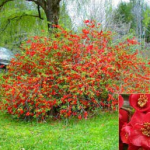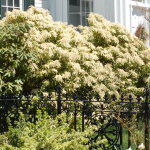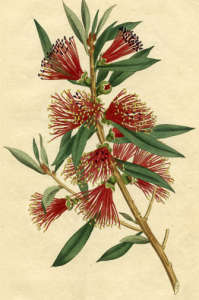The Copenhagen conference on climate change of the upcoming week shall be dealing with serious challenges for our planet, economies and lifestyle. It is conceivable that climate change, if it is not stopped or stopping of its own accord, will also have an impact on our gardens. Planting (im)possibilities and shifting flowering times immediately come to mind.
Smaller changes in weather or climate are of course quite common, and have always been. The winter of 1822 has apparently been a warm one in The Netherlands, judging to the fact that a newspaper article used the example of one shrub that had been in bloom during the whole winter, to illustrate that point. 1“Haarlem, den 18 Februarij. Als een zeldzaam bewijs van de zachte luchtsgesteldheid, kan men aanmerken, het gedurende den geheelen winter in de opene lucht bloeijen, van eene Pyrus Japonica, op de hofstede Bekestein, onder Velzen. De gemelde plant heeft thans de hoogte van 8 voeten bereikt en bloeit ter hoogte van zes voeten. Men telt aan dezelve 150 bloemen en ruim zoo veel knoppen.” ‘s Gravenhaagsche Courant, 18 February 1822, page 1.
 It grew in the garden of Beeckestijn, which is not far from the coast -and thus already in a milder climate because the relatively higher temperature of the sea water dampens the effects of winter in this part of the country. In the article the plant was called a “Pyrus Japonica” and it is possible that here the Pyrus japonica (Thunb) is meant; we now know this plant as Chaenomeles japonica, a prickly plant bearing fruit that ripens very late in the year.
It grew in the garden of Beeckestijn, which is not far from the coast -and thus already in a milder climate because the relatively higher temperature of the sea water dampens the effects of winter in this part of the country. In the article the plant was called a “Pyrus Japonica” and it is possible that here the Pyrus japonica (Thunb) is meant; we now know this plant as Chaenomeles japonica, a prickly plant bearing fruit that ripens very late in the year.
But it could also be the fine plant with small white flowers called Pieris japonica. 2There is one obvious and popular mistake in the writing of the name, so we can’t exclude other possible mistakes made by the journalist or during the printing stage. Both plants were discovered or first described by the same botanist, Thunberg.
Carl Peter Thunberg was a Swedish student of Linnaeus who lived from 1743-1828. He studied in Uppsala, Paris, Amsterdam and Leiden. In The Netherlands he joined the Dutch East India Company (V.O.C.) and traveled to Japan in December 1771. He returned in 1778 after visiting Japan and China and a short stop in South Africa on the way back. In 1784, back in Sweden, Thunberg published his Flora Japonica sistens plantas insularum japonicarum… (etc.), in which the Pyrus japonica is mentioned.
The news article goes on to say that the plant had 150 flowers in bloom in February 1822 and an equal amount of buds ready to go. A rather remarkable claim is that the plant was 8 feet (voet) high, which- if we take the (then) normal Rijnlandse Voet as a reference, would amount to a height of 2,54 meters. This means the plant must have stood there for quite a while, or had been planted there at a fairly old age.
The contemporary owner of Beeckestijn, Willem François Boreel (1775-1851), was a keen gardener, but at this stage he had owned the estate for only nine years -not enough to have a plant like this grow this large. 3In 1821 he had won a silver medal on a countrywide exhibition for an especially large and heavily blooming Metrosideros citrina (now Callistemon citrinus).
 https://www.historicalgardensblog.com/wp-content/uploads/2009/12/Metrosideros-citrina.png 335w" sizes="(max-width: 199px) 100vw, 199px" /> The original creator of the landscape garden at Beeckestijn had died in April 1778, six months before Thunberg returned from his voyage to the east. So the Pyrus japonica mentioned in the news article, probably a Chaenomeles japonica, has almost certainly been planted in the garden by Willem Boreel (1744-1796) or his wife and widow Maria Trip (1750-1813).
https://www.historicalgardensblog.com/wp-content/uploads/2009/12/Metrosideros-citrina.png 335w" sizes="(max-width: 199px) 100vw, 199px" /> The original creator of the landscape garden at Beeckestijn had died in April 1778, six months before Thunberg returned from his voyage to the east. So the Pyrus japonica mentioned in the news article, probably a Chaenomeles japonica, has almost certainly been planted in the garden by Willem Boreel (1744-1796) or his wife and widow Maria Trip (1750-1813).
Footnotes
| ↑1 | “Haarlem, den 18 Februarij. Als een zeldzaam bewijs van de zachte luchtsgesteldheid, kan men aanmerken, het gedurende den geheelen winter in de opene lucht bloeijen, van eene Pyrus Japonica, op de hofstede Bekestein, onder Velzen. De gemelde plant heeft thans de hoogte van 8 voeten bereikt en bloeit ter hoogte van zes voeten. Men telt aan dezelve 150 bloemen en ruim zoo veel knoppen.” ‘s Gravenhaagsche Courant, 18 February 1822, page 1. |
|---|---|
| ↑2 | There is one obvious and popular mistake in the writing of the name, so we can’t exclude other possible mistakes made by the journalist or during the printing stage. |
| ↑3 | In 1821 he had won a silver medal on a countrywide exhibition for an especially large and heavily blooming Metrosideros citrina (now Callistemon citrinus). https://www.historicalgardensblog.com/wp-content/uploads/2009/12/Metrosideros-citrina.png 335w" sizes="(max-width: 199px) 100vw, 199px" /> https://www.historicalgardensblog.com/wp-content/uploads/2009/12/Metrosideros-citrina.png 335w" sizes="(max-width: 199px) 100vw, 199px" /> |


